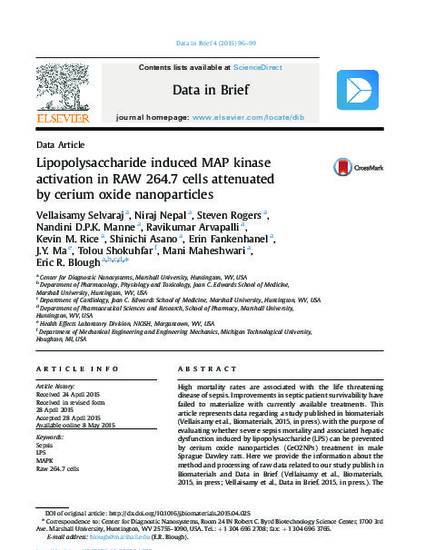
High mortality rates are associated with the life threatening disease of sepsis. Improvements in septic patient survivability have failed to materialize with currently available treatments. This article represents data regarding a study published in biomaterials (Vellaisamy et al., Biomaterials, 2015, in press). with the purpose of evaluating whether severe sepsis mortality and associated hepatic dysfunction induced by lipopolysaccharide (LPS) can be prevented by cerium oxide nanoparticles (CeO2NPs) treatment in male Sprague Dawley rats. Here we provide the information about the method and processing of raw data related to our study publish in Biomaterials and Data in Brief (Vellaisamy et al., Biomaterials, 2015, in press; Vellaisamy et al., Data in Brief, 2015, in press.). The data contained in this article evaluates the contribution of MAPK signaling in LPS induced sepsis. Macrophage cells (RAW 264.7) were treated with a range of cerium oxide nanoparticle concentration in the presence and absence of LPS. Immunoblotting was performed on the cell lysates to evaluate the effect of cerium oxide nanoparticle treatment on LPS induced changes in Mitogen Activated Protein Kinases (MAPK) p-38, ERK 1/2, and SAPK/JNK phosphorylation.

The copy of record is available from the publisher at https://doi.org/10.1016/j.dib.2015.04.022.
Copyright © 2015 The Authors. This article is available under the terms of the Creative Commons Attribution License (CC BY). You may copy and distribute the article, create extracts, abstracts and new works from the article, alter and revise the article, text or data mine the article and otherwise reuse the article commercially (including reuse and/or resale of the article) without permission from Elsevier. You must give appropriate credit to the original work, together with a link to the formal publication through the relevant DOI and a link to the Creative Commons user license above. You must indicate if any changes are made but not in any way that suggests the licensor endorses you or your use of the work.